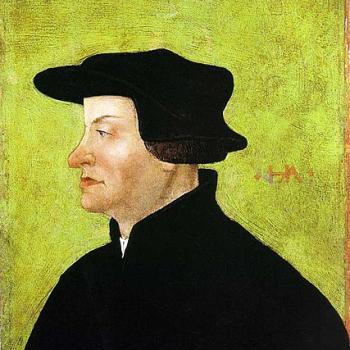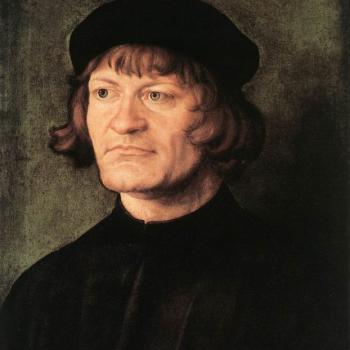
Moses and Aaron with the Ten Commandments: Creechurch Lane Spanish & Portuguese Synagogue, London (1674), painted by Aron de Chaves [public domain / Wikimedia Commons]
*****
(9-4-04)
***
This is a critique of an anti-Catholic article, entitled, “Catholic Religion Purposely takes out one of God’s Ten Commandments.” It listed alternate numbering of the Ten Commandments as follows:
First Commandment [Catholic]
I, the LORD, am your God…You shall not have other gods besides me.
First Commandment [KJV]
I am the LORD thy God…Thou shalt have no other gods before me.
Second Commandment [Catholic]
You shall not take the name of the LORD, your God, in vain.
Second Commandment [KJV]
Thou shalt not make unto thee any graven image, or any likeness above, or that is in the earth beneath, or that is in the water under the earth. Thou shalt not bow down thyself to them, nor serve them. [bolding in original]
Third Commandment [Catholic]
Remember to keep holy the sabbath day.
Third Commandment [KJV]
Thou shalt not take the name of the LORD thy God in vain.
Fourth Commandment [Catholic]
Honor your father and your mother.
Fourth Commandment [KJV]
Remember the sabbath day, to keep it holy.
Fifth Commandment [Catholic]
You shall not kill.
Fifth Commandment [KJV]
Honor thy father and thy mother.
Sixth Commandment [Catholic]
You shall not commit adultery.
Sixth Commandment [KJV]
Thou shalt not kill.
Seventh Commandment [Catholic]
You shall not steal.
Seventh Commandment [KJV]
Thou shalt not commit adultery.
Eighth Commandment [Catholic]
You shall not bear false witness against your neighbor.
Eighth Commandment [KJV]
Thou shalt not steal.
Ninth Commandment [Catholic]
You shall not covet your neighbor’s wife.
Ninth Commandment [KJV]
Thou shalt not bear false witness against thy neighbour.
Tenth Commandment [Catholic]
You shall not covet your neighbor’s house.
Tenth Commandment [KJV]
Thou shalt not covet.
I found the following information by simple recourse of a fifteen-minute perusal of my own library.
First of all, let’s get one thing straight right out of the “starting-gate”: the Bible itself does not lay out with precision, the numbering of the Commandments. In fact, it does not do so at all. The set is indeed referred to as “ten” (Ex 34:28, Deut 4:13, 10:4), but the exact numbering is not given in the two slightly different versions of it recorded in the Bible (Ex 20:2-17 and Deut 5:6-21; see also an expanded elaboration of the principles in Ex 34:11-28). This is as true of the King James Version as of any other. Therefore, no one has any license to be dogmatic about the exact numbering and division, based on the Bible alone — let alone to make a charge of dishonesty and “removal.”
This being the case, Christian groups have differed through the centuries, as to numbering. This is no “Catholic conspiracy.” Thus, The Oxford Dictionary of the Christian Church (2nd ed., edited by F. L. Cross and E. A. Livingstone, Oxford University Press, 1983, “Commandments, The Ten,” 318-319), notes:
. . . in the prohibition of covetousness, Ex. classes a man’s wife with his other domestic property, whereas Deut. treats her separately.
. . . There is a difference in the enumeration in the different Churches. In the C of E [Church of England] as well as in the Greek and the Reformed (Calvinist and Zwinglian) Churches the prohibitions relating to false worship are reckoned as two, whereas the RC Church and the Lutherans count them as one. Thus the enumeration of the subsequent Commandments differs, e.g., the fourth (Anglican, etc.) Commandment on the sanctification of the Sabbath is reckoned as the third by those following the RC method. The number ten is made up by splitting up the last Commandment forbidding covetousness into two.
So immediately we find that Martin Luther, the founder of Protestantism, and the Lutherans (no Catholics, they) are in on the “Romish” conspiracy to subvert the Ten Commandments. That makes the elegant anti-Catholic conspiratorialism not quite as simple and straightforward as is made out.
The Eerdmans Bible Dictionary (edited by Allen C. Myers, Grand Rapids, Michigan: Eerdmans Pub. Co., 1987) — also no organ of the Catholic Church –, in its article on the Commandments (p. 993), concurs:
At what points the Decalog is to be divided into precisely ten commandments has long been a matter of disagreement (e.g., some traditions regard v. 2 as the first commandment, combining vv. 3 and 4-6; others take vv. 3-6 as the first and divide v. 17 into two commandments). Debate also focuses on just where to divide the commandments into “two tables” (cf. 32:15; 34:4,28; Deut 4:13) . . .
The Protestant New International Dictionary of the Christian Church (edited by J. D. Douglas, Grand Rapids, Michigan: Zondervan Publishing House, rev. ed., 1978, 243) sheds further light on the differences in enumeration:
The Talmudic tradition held that the commandments against idolatry and the forbidding of images formed one long, indivisible unit. Augustine, who was followed by the Roman and Lutheran traditions, accepted this suggestion and found two commandments under the rubric “thou shalt not covet.” A further tradition, following the lead of Origen, separated the commandment against images from that against idolatry; this is the view of Calvin and the Reformed tradition.
(cf. #2066 in Catechism of the Catholic Church)
Ah; how the plot thickens now! Or, rather, how many unanswered questions arise! The great St. Augustine: practically the patron saint of all Protestants, now has espoused (and it looks like he actually originated) the great plot to change the Commandments, so as to allow idolatry to flourish in Catholic ranks. The anti-Catholic choices here reduce to only a very few:
1. Boot St. Augustine out of the pantheon of Protestant heroes, due to his joining in the “wicked” conspiracy (or at the very least, include him, when making the condemnation).
2. Admit that he started this, but that the theory itself is bogus, and drop the charge altogether.
3. Claim that he was hypnotized by evil “Romish” priests and wrote what he did under compulsion; it wasn’t his true view on the subject.
Of course, the same would apply to Martin Luther and Lutherans to this day, which creates even more obviously thorny problems for a Protestant making this (ridiculous) charge. Another absurdity derives from the fact that the Orthodox follow the non-Lutheran Protestant enumeration, yet they fully accept veneration of images, just as Catholics do. So they apparently missed the “trick” that the Catholics devised, to hide their devious practices. Luther was against such veneration (in the main), yet followed the Catholic tradition on this score. Go figure.
Thus in his famous Large Catechism (my version is from Minneapolis: Augsburg Publishing House, 1935), Luther’s numbering (like Augustine’s before him) is precisely that of the Catholic Church. The relevant section can be found on pages 44-112. The Small Catechism is the same. Both are normative for Lutherans; they are included in the confessional Book of Concord (1580). The First Commandment is written in these works as: “Thou shalt have no other gods before me.” The Second Commandment is listed as: “Thous shalt not take the name of Jehovah thy God in vain; for Jehovah will not hold him guiltless that taketh his name in vain” (pp. 44, 53 of Luther’s Large Catechism). Anti-Catholicism always involves this sort of outrageous double standards and hiding of the full truth of the matter.
The claim is that Catholics “deleted” the Commandment about “graven images” and “idols.” But this is understood (by Augustine, Luther, and Catholics) as included within the first commandment. It’s not excluded. There is merely a “shorthand” to remember the first commandment, in the shorter version, just as “Thou shalt not covet” in the non-Lutheran Protestant versions is shorthand for the longer, more explicit biblical version.
There is no subterfuge here at all. We can go back to the 16th-century Catechism of the Council of Trent to prove this (my version is translated by John A. McHugh and Charles J. Callan, published in New York by Joseph F. Wagner; second revised edition, 1923). Part III, the section on “The Decalogue,” runs from pages 357-477. On page 366 “The First Commandment” is written out in a very long form: it covers the entirety of Exodus 20:2-6. This is quite strange if the Council of Trent was in on this conspiracy to keep the Catholic unwashed, ignorant masses ignorant of the basic theology of monotheism and prohibition of idolatry. Didn’t they know that the Catholic Church was supposed to “kill people with Bibles”? This great Catechism explains the rationale for the numbering of the Catholic First Commandment:
Some, supposing these words which come next in order to constitute a distinct precept, reduce the ninth and tenth Commandments to one. St. Augustine, on the contrary, considering the last two to be distinct Commandments, makes the words just quoted [Ex 20:4-5a, or the non-Lutheran Protestant 2nd Commandment] a part of the First Commandment [Super Exod. quaest. 71, and in Ps. xxxii, serm. ii]. His division is much approved in the Church, and hence we willingly adopt it. Furthermore, a very good reason for this arrangement at once suggests itself. It was fitting that to the first Commandment should be added the rewards or punishments entailed by each one of the Commandments. (p. 373)
Augustine’s (and the Catholic) outlook is not quite the reason that the anti-Catholic authors of this hit piece would have us believe (deceit, deception, etc.) . . .
Likewise, the recent Catechism of the Catholic Church, in listing the First Commandment (#2083; cf. #2128-2132) incorporates Exodus 20:2-5a (including the “graven image” material”). So we see that the writers of this hugely influential work are in the dark as to the conspiracy supposedly at play here to suppress one of the Commandments.
We can even go back to St. Thomas Aquinas, in the 13th century. His catechism has the long version of the First Commandment [see link to the left and further elaboration by St. Thomas]. Here is an objective look at the differences, without the silly polemics and charges of dishonesty.
The entire theory is ludicrous. This is some of the most ridiculous “reasoning” I’ve ever seen, even by rock-bottom anti-Catholic standards of “scholarship” and fairness.
***












